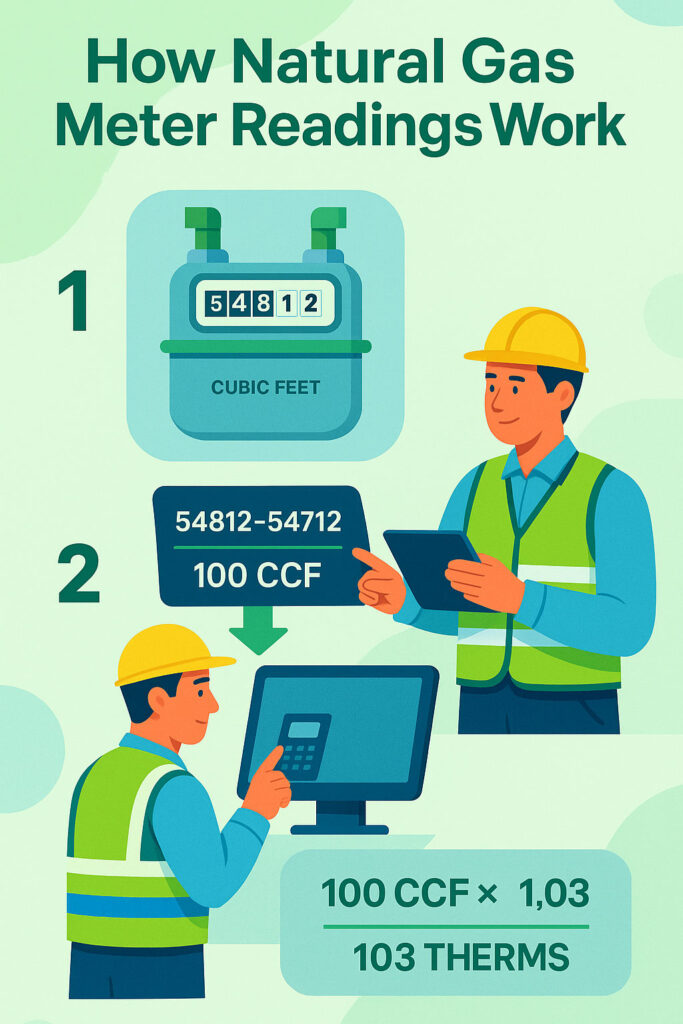Key Takeaways
- CCF and therms are the most common units on residential gas bills. 1 CCF is approximately the same as 1 therm.
- BTUs help measure the heating power of your appliances.
- MCF is used for larger-scale gas consumption. 1 MCF is equal to 10 CCF.
If you’ve ever looked at your gas bill and felt confused by the different units of measurement, you’re not alone! Natural gas is measured in a few common ways: CCF, MCF, BTU, and therms. Each one tells a slightly different story about how much gas you’re using and how much energy it provides. Let’s break them down in an easy-to-understand way!
CCF (Hundred Cubic Feet)
What it is: CCF stands for “hundred cubic feet” and measures the volume of natural gas. One CCF equals 100 cubic feet of gas.
Why it matters: This is one of the most common units you’ll see on your gas bill. If your bill says you used 10 CCF, that means you consumed 1,000 cubic feet of natural gas in that billing period.
Therms
What it is: A therm is a unit of heat energy equal to 100,000 BTUs. It’s a practical way to measure the energy content of natural gas.
Why it matters: Many residential gas bills use therms to calculate charges. If your bill says you used 50 therms, that means you consumed 5,000,000 BTUs worth of energy.
MCF (Thousand Cubic Feet)
What it is: MCF stands for “thousand cubic feet” and represents a larger volume of gas. One MCF equals 1,000 cubic feet (or 10 CCF).
Why it matters: MCF is typically used for commercial or industrial gas usage. However, if you have a larger home with high gas consumption, you might see MCF used instead of CCF.
BTU (British Thermal Unit)
What it is: A BTU measures the energy content of natural gas, essentially, how much heat it can produce. One BTU is the amount of energy needed to heat one pound of water by one degree Fahrenheit.
Why it matters: BTUs help describe the heating power of appliances like furnaces, water heaters, and stoves. For example, a furnace might be rated at 80,000 BTUs per hour, meaning it produces that much heat when running at full capacity.
How These Units Relate to Your Home
- What you’ll see on your bill: Most residential gas bills use CCF or therms to track usage.
- Typical household usage: An average home might use 50–100 therms per month in the winter for heating, cooking, and hot water.
Quick conversions:
1 CCF ≈ 1 therm
1 therm = 100,000 BTU
1 MCF = 10 CCF ≈ 10 therms
How Natural Gas Meter Readings Work

Understanding how your natural gas usage is measured can help demystify your monthly utility bill. Most residential gas meters measure the volume of gas in cubic feet, usually displayed as a series of rotating dials or digital numbers on the meter face. However, as mentioned previously, the amount you’re billed for is typically in CCF (hundreds of cubic feet) or Therms, depending on your utility company.
Here’s how the process works:
- Your meter tracks how many cubic feet of gas you’ve used.
- The gas company periodically reads your meter and subtracts the last reading to calculate your usage.
- Because the energy content of natural gas can vary, your provider applies a BTU factor (or “conversion factor”) to convert the raw volume into Therms, a more accurate measure of the energy you’re actually using.
- For example, if you used 100 CCF and the BTU factor is 1.03, your bill would reflect 103 Therms of usage.
Some bills include both the CCF and the conversion to Therms, so don’t be surprised if you see multiple units. And if your home has a smart meter, this information may be updated digitally, letting you track usage more frequently online.
Easy Ways to Reduce Natural Gas Usage
Reducing your gas usage isn’t just great for the environment, it can also make a noticeable difference on your monthly utility bill, especially during colder months. Here are a few simple yet powerful ways to conserve:
- Replace Your Air Filter Regularly
A clogged furnace filter makes your heating system work harder and use more gas. Replace filters every 1-3 months during heating season to keep airflow smooth and efficient. - Install a Smart Thermostat
Smart thermostats, like Nest or EcoBee, can automatically adjust the temperature based on your habits or when you’re away, helping to reduce unnecessary heating. Some models can cut heating costs by up to 10% annually. - Switch to Low-Flow Showerheads
Heating water for showers is a major source of gas usage. A low-flow showerhead uses less hot water, reducing the demand on your water heater without sacrificing comfort. - Weatherize Your Home
Sealing air leaks around windows, doors, and ductwork can prevent warm air from escaping and cold drafts from getting in. Consider adding weather stripping, caulking, or insulation upgrades to stay warmer without cranking up the heat.
Even small changes can add up to big savings over time.
Learn more about Ways to Save on Your Natural Gas Bill
Understanding these units can help you better track your gas usage and manage your energy costs. The more you know, the easier it is to make informed decisions about your home’s energy efficiency!
About the Author
David has been an integral part of some of the biggest utility sites on the internet, including InMyArea.com, HighSpeedInternet.com, BroadbandNow.com, and U.S. News. He brings over 15 years of experience writing about, compiling and analyzing utility data.
